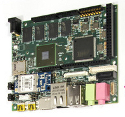pcDuino SBC adopts i.MX6 Quad, loads up on storage
Oct 3, 2014 — by Eric Brown 4,255 views LinkSprite unveiled a “pcDuino Acadia 1” SBC that runs Linux or Android on a 1.2GHz Freescale i.MX6 Quad SoC and features eMMC flash and dual microSD slots.
LinkSprite unveiled a “pcDuino Acadia 1” SBC that runs Linux or Android on a 1.2GHz Freescale i.MX6 Quad SoC and features eMMC flash and dual microSD slots.
LinkSprite Technologies, which hosts the open source project for pcDuino single board computers, last month announced a pcDuino3Nano SBC, featuring a dual-core, 1GHz Cortex-A7 Allwinner A20 system-on-chip for only $39. At last weekend’s Maker Faire New York, the company unveiled a quad-core based SBC called the pcDuino Acadia 1. No pricing or availability information was released.

pcDuino Acadia 1
(click image to enlarge)
The pcDuino Acadia 1 is the first pcDuino board to stray from the Allwinner line of SoCs. Instead it uses Freescale’s Cortex-A9-based i.MX6, jumping right to the top with the 1.2GHz quad-core version. The four ARM cores are supported with the Vivante GC2000 GPU with OpenGL/ES 2.x, OpenCL EP, and OpenVG 1.1 acceleration. The i.MX6 enables the Acadia 1 to generate multi-format 2048 x 1536-pixel resolution via the HDMI port.
 UDOO Quad |
Like the i.MX6 Quad-based UDOO Quad SBC, the Acadia 1 offers 1GB of RAM. Unlike the UDOO Quad, it also supplies onboard flash — a generous 8GB of eMMC. Instead of one microSD slot, it provides two, offering combined storage of up to 128GB plus the onboard flash.
— ADVERTISEMENT —
Like the UDOO Quad, the 120 x 65mm Acadia 1 provides HDMI and LVDS connections, as well as a SATA socket and a gigabit Ethernet port. The Acadia 1 furnishes two cameras interfaces (MIPI and CSI) instead of one. There is also a pair of USB host ports, a USB OTG port, and an audio jack. Like the UDOO Quad, the pcDuino board offers an Arduino Uno compatible header with various I/O as shown below. An IR receiver is also available.
One big advantage the UDOO Quad has over the Acadia 1 is its onboard WiFi module. We’ll have to wait for the Acadia 1 price to see how that comparison shakes out.
The device “can adapt to a variety of harsh environments,” says LinkSprite, although no temperature range was supplied. As usual with pcDuino boards, there’s support for Ubuntu 12.04 or Android 4.4.
Summary of pcDuino Acadia specs
Specifications listed for the pcDuino Acadia 1 include:
- Processor — Freescale i.MX6 Quad (4x Cortex-A9 cores @ up to 1.2GHz); Vivante GC2000 with OpenGL/ES 2.x, OpenCL EP, and OpenVG 1.1 acceleration
- Memory/storage:
- 1GB DRAM
- 8GB eMMC flash
- 2x microSD slots for up to 128GB
- SATA host socket
- Display/camera:
- HDMI 1.4 out with HDCP support
- LVDS interface
- MIPI camera interface
- CSI camera interface
- Networking — gigabit Ethernet port
- Other I/O:
- 2x USB host ports
- 1x USB OTG port
- 3.5mm audio jack
- IR receiver
- Arduino Uno compatible socket:
- 14x GPIO
- 2x PWM
- 6x ADC
- 1x each UART, SPI, I2C
- Power — 5V, 2000mA; Li-Poly Battery Interface
- Dimensions — 120 x 65mm (4.72 x 2.56 in.)
- Operating system — Ubuntu Linux 12.04; Android 4.4
Further information
No pricing or availability information was provided for the pcDuino Acadia 1. More information may be found at the pcDuino Acadia 1 announcement page.

Please comment here...